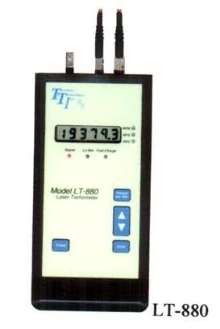Laser Tachometer operates at 40 kHz.
Press Release Summary:
 Hand-held, battery-operated, Model LT-880 senses passage of reflective/non-reflective markings of rotating or linearly translated piece of machinery to determine target's rotational rate or linear velocity. Fiber-coupled sensing head is remote from electronics package. Six-digit LCD display indicates rate of passage of white/dark areas of encoder and registers results in units of rpm, rps, or pps. Reading is updated twice per second.
Hand-held, battery-operated, Model LT-880 senses passage of reflective/non-reflective markings of rotating or linearly translated piece of machinery to determine target's rotational rate or linear velocity. Fiber-coupled sensing head is remote from electronics package. Six-digit LCD display indicates rate of passage of white/dark areas of encoder and registers results in units of rpm, rps, or pps. Reading is updated twice per second.Original Press Release:
TTI Announces the New LT-880 Laser Tachometer
Oriskany New York, April 1, 2004: Terahertz Technologies Inc. announces the introduction of the new LT-880 Laser Tachometer with a six digit LCD display for revolutions per minute,
revolutions per second, or pulses per second. The LT-880 Laser Tachometer is a hand-held, battery operated device that senses the passage of reflective/non-reflective markings on a rotating
or linearly translated piece of machinery in order to determine the target's rotational rate or its linear velocity. The sensing head is remote from the electronics package and is fiber coupled. This permits measurement of objects in hostile environments or in hard-to-get-to locations. The sensed change in reflectivity from black to white generates a transition at its output. A spectrum analyzer, computer or electronic counter may utilize this TTL/CMOS compatible signal in order to provide information concerning vibration, angular or linear velocity of the machineiy under test. The high speed of the unit, 40 KHz, coupled with its small spot size can provide high-resolution measurements unattainable with conventional incandescent source tachometers.
A six digit LCD display indicates the rate of passage of the white/dark areas of the encoder and registers the results in units of revolutions per minute, (RPM), revolutions per second, (RPS), or pulses per second (PPS). The reading is updated twice per second. The user may input the number of pulses per revolution of the encoder for use in the subsequent calculations. They may range from 1 pulse per revolution to 255 pulses per revolution.




